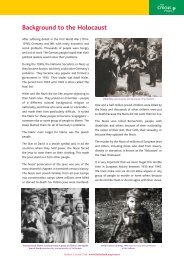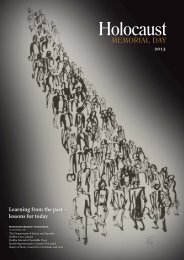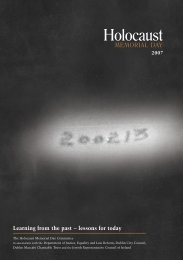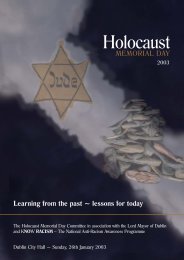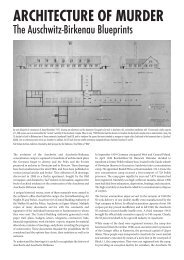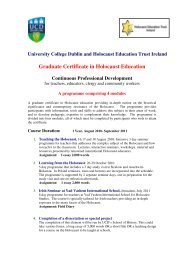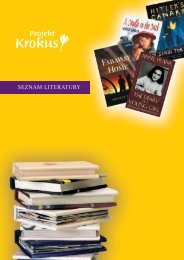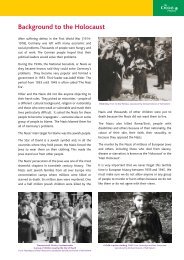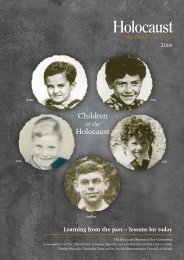Learning from the past ~ lessons for today - Holocaust Education ...
Learning from the past ~ lessons for today - Holocaust Education ...
Learning from the past ~ lessons for today - Holocaust Education ...
You also want an ePaper? Increase the reach of your titles
YUMPU automatically turns print PDFs into web optimized ePapers that Google loves.
<strong>Holocaust</strong> Memorial Day 2012<br />
Terezin<br />
The Terezin concentration camp outside Prague (in <strong>the</strong> old<br />
<strong>for</strong>tress of Theresienstadt) was created to cover up <strong>the</strong><br />
Nazi genocide of <strong>the</strong> Jews. A high proportion of artists<br />
and intellectuals was incarcerated in Terezin, and culture<br />
flourished. A Red Cross inspection in 1944 found Terezin<br />
to be a “model ghetto”. However, what <strong>the</strong> Red Cross<br />
inspectors did not see was <strong>the</strong> starvation, disease and <strong>the</strong><br />
constant dread of transports to <strong>the</strong> death camps of <strong>the</strong><br />
east. Those who were brought to Terezin in crowded cattle<br />
cars after days of cruelty, humiliation and beatings,<br />
wanted to believe that here <strong>the</strong>y would be safe. All of<br />
<strong>the</strong>m were deceived; <strong>the</strong> same fate awaited <strong>the</strong>m; every<br />
one of <strong>the</strong> Terezin inmates was condemned in advance to<br />
die. Between 1942 and 1944, 140,000 Jews passed<br />
through Terezin, 123,440 perished., Fifteen thousand<br />
were children of whom fewer than 100 survived.<br />
For a time, <strong>the</strong> children played, studied, drew pictures<br />
and wrote poems. Their poems and drawings allow us to<br />
see through children’s eyes what no child should ever<br />
have to see. But <strong>the</strong>y were children. They also drew and<br />
wrote about gardens and butterflies, warm colourful<br />
homes, happier times, feeding <strong>the</strong>ir kittens. In <strong>the</strong>ir art,<br />
we see <strong>the</strong>ir courage, <strong>the</strong>ir optimism, <strong>the</strong>ir hopes and<br />
<strong>the</strong>ir fears. They lived, locked within <strong>the</strong> walls and<br />
courtyards of Theresienstadt. It became <strong>the</strong>ir world, a<br />
world of colour, shadow, hunger and hope.<br />
The Butterfly<br />
The last, <strong>the</strong> very last,<br />
So richly, brightly, dazzlingly yellow.<br />
Perhaps if <strong>the</strong> sun’s tears would sing<br />
against a white stone…<br />
Such, such a yellow<br />
Is carried lightly ‘way up high’.<br />
It went away I’m sure because it wished to go<br />
kiss <strong>the</strong> world good-bye.<br />
For seven weeks I’ve lived in here,<br />
Penned up inside this ghetto.<br />
But I have found what I love here.<br />
The dandelions call to me<br />
And <strong>the</strong> white chestnut branches in <strong>the</strong> court.<br />
Only I never saw ano<strong>the</strong>r butterfly.<br />
That butterfly was <strong>the</strong> last one.<br />
Butterflies don’t live in here,<br />
in <strong>the</strong> ghetto.<br />
Pavel Friedmann, aged 17,<br />
June 1942, Theresienstadt<br />
This poem was found amongst a cache of children’s artwork at<br />
<strong>the</strong> end of <strong>the</strong> war that had been hidden by <strong>the</strong> artist Friedl<br />
Dicker-Brandeis who was a prisoner in Theresienstadt. It was<br />
subsequently deposited in <strong>the</strong> Jewish Museum, Prague.<br />
Pavel was eventually deported <strong>from</strong> Theresienstadt to<br />
Auschwitz, where he died on 29 September 1944.<br />
Fall<br />
Fall is here.<br />
The leaves turn yellow on<br />
<strong>the</strong> trees,<br />
<strong>the</strong> campfire dies out.<br />
My thoughts are far <strong>from</strong><br />
here,<br />
somewhere far,<br />
where integrity lives.<br />
It lives in my friend.<br />
Now I think of her.<br />
Memories ga<strong>the</strong>r ‘round<br />
me<br />
Like falling leaves.<br />
A. Lindtova<br />
I’d like to go alone<br />
I’d like to go away alone<br />
Where <strong>the</strong>re are o<strong>the</strong>r,<br />
nicer people,<br />
Somewhere into <strong>the</strong> far<br />
unknown,<br />
There, where no one kills<br />
ano<strong>the</strong>r.<br />
Maybe more of us,<br />
A thousand strong,<br />
Will reach this goal<br />
Be<strong>for</strong>e too long.<br />
Alena Synkova<br />
Petr Ginz<br />
Petr Ginz was a 14-year-old<br />
Jewish boy <strong>from</strong> Prague who<br />
was deported to <strong>the</strong><br />
Theresienstadt ghetto in 1942.<br />
He was a very bright and<br />
talented young man and <strong>the</strong><br />
driving <strong>for</strong>ce behind Vedem (we<br />
lead), <strong>the</strong> weekly newspaper produced by <strong>the</strong> boys in his<br />
barracks. Written by hand and read out loud every<br />
Friday evening, <strong>the</strong> newspaper consisted of essays,<br />
poems and short stories as well as a weekly column,<br />
Strolls Through Theresienstadt in which Ginz and his<br />
friends reported on various parts of <strong>the</strong> ghetto <strong>from</strong> <strong>the</strong><br />
bakery to <strong>the</strong> morgue. On 28 September 1944 Petr Ginz<br />
was put on a train to Auschwitz and sent to his death in<br />
a gas chamber immediately upon his arrival. He was 16<br />
years old.<br />
19






